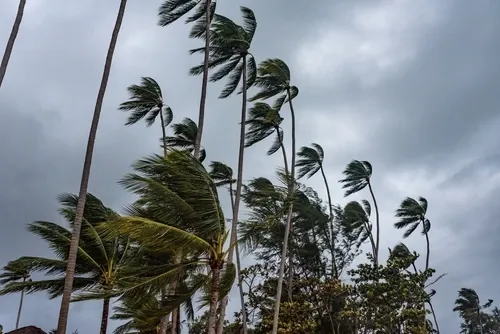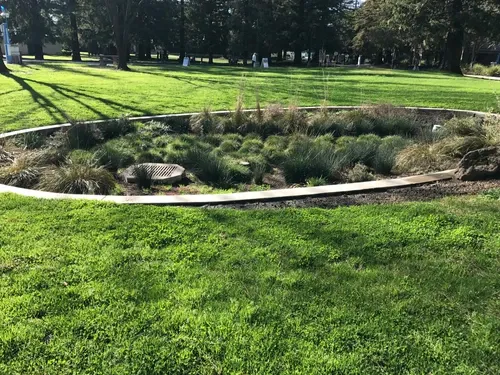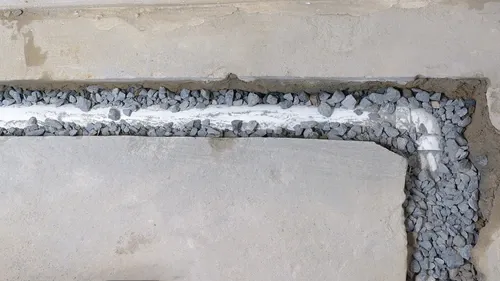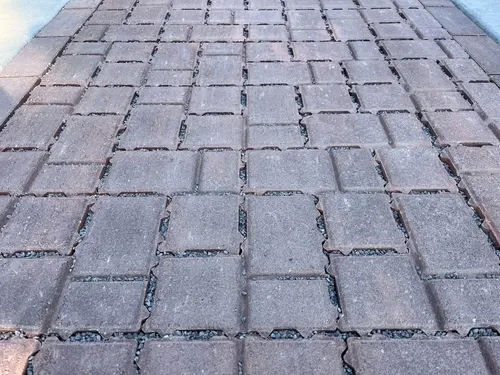
The Grounds Guys experts share valuable insights on creating a hurricane-ready yard:
|
When hurricane season arrives, your landscape can become your home's best defense or its greatest vulnerability. Strategic landscaping choices can dramatically reduce wind damage and prevent costly flooding. The right combination of wind-resistant plants, smart drainage solutions, and sturdy hardscape elements creates a natural barrier that helps your yard weather even the strongest storms.
You don't need to sacrifice beauty for protection. Explore this comprehensive guide to discover smart hurricane-resistant landscaping ideas that can enhance your property's curb appeal while keeping your family and home safer.
Why Hurricanes Destroy Landscapes
Hurricanes unleash multiple forces that can devastate your landscaping. High winds can snap trees and uproot plants, flooding drowns root systems and washes away soil, and flying debris turns everyday objects into projectiles. Even a seemingly healthy oak tree poses a major risk in the face of 100-mph winds!
If you live in a hurricane-prone area, take a walk around your property and note any vulnerabilities, such as shallow-rooted trees, areas where water pools after heavy rain, and outdoor furniture that could become airborne. These areas need attention before the next storm season arrives.
Wind-Resistant Trees: What to Plant and Where to Put Them
Professional landscape design services can help you select wind-resistant trees based on your location. A strategic planting plan will maximize protection while enhancing the beauty of your property.
Trees that typically survive hurricanes
Native, wind-resistant trees form the backbone of hurricane-ready landscapes. These hardy species have deep root systems and flexible wood that bends instead of breaking during storms.
- Live oak & sand live oak: Natives with dense wood and extensive root systems that withstand extreme winds.
- Bald cypress: Wetland species with strong trunk structure that tolerates both wind and flooding.
- Southern magnolia: Evergreen with thick branches and a sturdy growth pattern.
- Sabal palm (cabbage palm): Palm with a flexible trunk that bends without snapping.
- Gumbo limbo: Soft wood bends with the wind rather than breaking; regenerates quickly after damage.
- American holly: Slow growth creates dense, strong wood that resists wind damage.
- Crape myrtle: Smaller tree with proven wind resistance and multiple-trunk structure.
Where to plant trees for hurricane defense
Proper placement matters almost as much as species selection!
- Large trees: Plant away from your home and any nearby power lines, giving their roots plenty of space to spread.
- Mixed trees: Groups of mixed trees protect each other better than single specimens, creating natural windbreaks that benefit your entire property.
Pro tip: Leafy trees catch heavy winds like sails. Regular pruning strengthens these trees against storm forces by removing weak branches and thinning dense canopies.
Stop Flooding Before It Starts With Smart Landscaping
Heavy rainfall during hurricanes can overwhelm your property's natural drainage capacity, leading to pooling and potential flood damage. Strategic landscaping can help redirect stormwater away from vulnerable areas while protecting your soil from erosion.
Rain gardens

Rain gardens feature native species that thrive in wet conditions, planted in low-lying areas to capture runoff.
- Strategically placed rain gardens can collect runoff from roofs, driveways, and slopes, allowing water to slowly infiltrate into the soil instead of rushing toward storm drains or your foundation.
- Plants like blue flag iris, cardinal flower, and native grasses that tolerate both wet and dry conditions make attractive and functional additions to a rain garden.
Smart drainage
French drains and bioswales channel water along predetermined paths toward rain gardens and other safe drainage areas.

French drains use a perforated pipeline buried beneath a substrate (typically gravel) to collect and divert water from high-risk areas.

Bioswales work similarly but guide water along a channel lined with vegetation. Bioswales are commonly integrated into landscape design using a creekbed motif.
Pro tip: Size your rain garden to handle about 30% more water than your property typically receives during heavy storms.
How to grade your yard for storm drainage
Proper grading creates gentle slopes that guide water flow away from your home's foundation. Even a modest 2% slope can prevent water from pooling near structures!
- Storm grading starts at the foundation and slopes gently away from your home at a minimum 2% grade for the first 10 feet (about 2.5 inches of drop).
- Avoid creating valleys or low spots where water can collect. Instead, use gentle ridges and swales to direct water toward designated drainage areas, such as rain gardens or storm drains.
Professional grading may require moving substantial amounts of soil, but even minor adjustments around problem areas can prevent water from pooling near your home during the next big storm.
Hurricane-Proof Hardscape Features That Stay Put
Well-designed hardscape elements anchor your landscape during storms and provide structure that plants alone cannot.
Retaining walls
With proper drainage and reinforcement, retaining walls can redirect water flow while preventing soil erosion on slopes. Choose materials like natural stone or interlocking concrete blocks that can flex slightly without cracking under pressure.
Permeable pavers

Unlike traditional concrete pavers, permeable pavers feature gapped joints, allowing stormwater to drain more effectively. This reduces runoff and prevents pooling, offering the best of both worlds for patios and walkways.
Permanent garden edging
Garden borders and edging should be substantial enough to contain mulch and soil during heavy rains. Steel or concrete edging is more effective than plastic alternatives, which can crack or shift.
Ready to get started? Professional hardscape design ensures that these features integrate seamlessly with your landscape's drainage plan while providing long-term durability.
Your Pre-Hurricane Landscape Checklist (Don't Skip This)
Hurricane preparation starts months before storm season arrives. Use this checklist to ensure your landscape is ready to weather the next big storm.
Late winter/early spring
- Walk your entire property to identify weak tree branches and damaged plants.
- Remove dead or diseased limbs that could break off in high winds.
- Thin overly dense tree canopies to reduce wind resistance.
- Avoid topping trees—it actually weakens their structure!
- Use rain gardens and directed runoff techniques to address areas with poor drainage.
Before each storm season
- Secure or remove outdoor furniture, planters, and garden tools.
- Store loose items in a garage or shed.
- Permanently anchor decorative elements to hardscape features.
- Trim back overgrown shrubs that block windows or crowd your home's exterior.
Year-round maintenance
- Clear debris from gutters, downspouts, and storm drains regularly.
- Test rain gardens and bioswales during heavy rains.
- Monitor tree health for signs of disease or structural weaknesses.
- Keep emergency contact information for tree removal services handy.
If you’re not sure where to start, consider scheduling professional landscape maintenance. Landscaping experts can identify potential problems, recommend hurricane-resistant features, and provide high-quality upkeep to ensure your home is ready for the next storm.
When DIY Hurricane Landscaping Isn't Enough
Hurricane landscape design works best when planned by professionals. Whether your property requires large tree removal or major pruning, extensive grading and drainage projects, or a retaining wall over three feet tall, professional landscapers provide quality, code-compliant workmanship.
At The Grounds Guys®, we understand how to design and build integrated landscaping features that look great while defending your property against storm damage. Our landscape and hardscape services provide the expertise, equipment, and insurance coverage required for major hurricane preparation projects. Request a job estimate for storm landscape services today!
This article is intended for general informational purposes only and may not be applicable to every situation. You are responsible for determining the proper course of action for your home and property. The Grounds Guys are not responsible for any damages that occur as a result of this blog content or your actions. For the most accurate guidance, contact The Grounds Guys location nearest you for a comprehensive, on-site assessment.
FAQs About Hurricane-Resistant Landscaping
As an industry leader, The Grounds Guys are committed to using our 20+ years of landscape knowledge and experience to help bring the vision for your property to life. This includes answering your questions about landscape and lawn care services. Below are answers to some of the most frequently asked questions about hurricane-resistant landscaping.
What plants are best for hurricane-resistant landscaping?
Native plants with flexible stems, deep root systems, and low wind resistance work best for hurricane-resistant landscaping. These plants bend rather than break in high winds and recover quickly after storms.
Best hurricane-resistant plants:
- Native grasses that flex with the wind and have extensive root systems
- Palm trees with flexible trunks that bend without breaking
- Live oaks with deep roots and strong wood structure
- Shrubs like firebush and coontie that recover quickly from damage
- Ground cover plants that prevent soil erosion during heavy rains
Plants to avoid:
- Brittle trees (like eucalyptus) that snap easily in high winds
- Shallow-rooted species that topple during storms
How can landscaping help prevent flooding during hurricanes?
Strategic landscape design utilizes drainage strategies, grading, and hardscape features to minimize flooding during storms.
- Drainage: Rain gardens and runoff pathways, such as French drains or bioswales, can help direct runoff away from structures.
- Grading: Even a 2% slope away from the base of your home can help prevent pooling and potential flood damage.
- Permeable pavers: Pavers with built-in drainage features allow water to drain naturally.
- Water-absorbing plants: Native plants with deep roots are much better at soaking up water than regular grass.
When should I hire a professional hurricane tree service before storm season?
Schedule professional tree services 2–3 months before hurricane season for assessment and pruning. Qualified arborists can identify weak or damaged branches, thin out dense canopies to reduce wind resistance, and remove trees that pose risks to your home.
Preventive tree care helps avoid the need for emergency services after storms when damage has already occurred. Reach out to your local Grounds Guys team to learn more and request professional hurricane tree services.